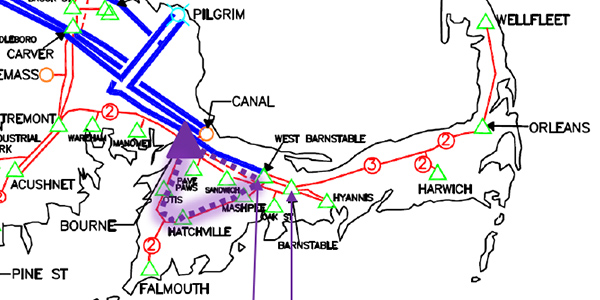ISO-NE last week presented its notice of initiation for the Cape Cod Resource Integration Study, which will focus on potential infrastructure to interconnect queued generation and quantify resources that could interconnect with new transmission according to the network capability interconnection standard (NCIS).
Conceptual cluster-enabling transmission upgrades include adding new 345-kV transmission infrastructure between West Barnstable and Bourne, Mass. The study will also identify the number of megawatts that could be interconnected while recognizing the export limitation from Cape Cod from a 2019 economic analysis by the New England States Committee on Electricity (NESCOE).
Al McBride, a system planner for ISO-NE, said the RTO had completed several interconnection studies on Cape Cod, most recently a system impact study for the proposed Vineyard Wind 2, which would connect to the 345-kV West Barnstable substation.
The project, which is under evaluation by utilities in Massachusetts, could be either 400 or 800 MW; ISO-NE studied the 800-MW option. It would require network upgrades, including a 345-kV line from West Barnstable to Bourne, a new 345-kV substation at Bourne and a 345/115-kV autotransformer at West Barnstable.
There are also several more interconnection requests in the queue, including 2,948 MW of generation and an elective transmission upgrade, seeking to interconnect to Barnstable/West Barnstable or Bourne.
The conditions used in NCIS system impact studies, described in Planning Procedure 5-6, include peak-load and light-load testing and resources modeled at their nameplate ratings (50 or 0 degrees Fahrenheit, as appropriate). New resources may also dispatch against existing resources under NCIS interfaces modeled at the transfer limit.
One admittedly “curious” stakeholder asked McBride why the RTO is initiating this study now, as potentially eligible projects for this cluster have already had feasibility studies done.
“This isn’t a new realization that there are more megawatts here than can be fully deliverable from the cape,” the stakeholder said.
McBride said there was consideration given to starting the cluster “sooner … but because we were able to complete [the Vineyard Wind 2 study] serially, we did so, and we feel that’s the way that the process is supposed to be implemented.” McBride added that “given our experiences with [Vineyard Wind 2], and what we were seeing on the system, and then our jump ahead into the future through the economic study … all of the conditions became apparent, and so that’s why we’re initiating it now.”
Another stakeholder asked McBride if the peak load for Cape Cod “is different rather than simultaneous with the system peak, how is it going to be handled in this study?”
“Somewhere like the cape, for nine months to approximately a year, you’re going to be experiencing lower loads, and you might use less of these injected megawatts,” McBride said. “And if there are any time constraints, getting megawatts off the cape might add to that. … I don’t have anything necessarily specific that we might add into this study, but it’s something that we’re thinking of, and if we have anything more, we’ll come back” to the committee.
The RTO will accept additional stakeholder feedback on the initial conceptual transmission upgrades until Nov. 20 and present results of the Cape Cod Resource Integration Study within 12 months. However, the economic analysis previously performed by NESCOE and the interconnection studies is expected to speed up this time frame.
After the publication of the final report, the RTO will open the window for eligible projects to proceed to the cluster system impact study (CSIS) phase. Eligible projects must meet CSIS entry requirements to move into the study, including submitting a cluster participation deposit.
Lessons Learned on Order 1000 Competitive Solicitations Process
ISO-NE’s Michael Drzewianowski introduced the RTO’s plans to gather feedback for “lessons learned” on competitive solicitations under FERC Order 1000. The recently completed Boston 2028 transmission solicitation was the RTO’s first-ever request for proposals under Order 1000.
“While the cost of the competitive solicitation was considered a success, the ISO and stakeholders have noted areas that could be improved, and the ISO is taking this formal process to collect and evaluate feedback from stakeholders,” Drzewianowski said.
The RTO ran its initial RFP from December 2019 through July of this year. The process concluded with selecting a $49 million project by utilities National Grid and Eversource Energy, which was the cheapest of the 36 received proposals. (See ISO-NE Chooses Incumbent as Boston RFP Winner.) ISO-NE also promised stakeholders, who challenged its selection process, discussions on what did not work well or could be improved in future RFPs and their execution, including developing a submittal template that will summarize any recommendations and guide Tariff and process changes. Drzewianowski added that the RTO already initiated one-on-one discussions with qualified transmission project sponsors who submitted proposals.
Drzewianowski said if there are issues with the RFP or suggested improvements, he would encourage stakeholders to work through the process. Comments on the draft lessons learned submittal template are due Nov. 2, and the final template will be distributed at the Nov. 6 PAC meeting. Completed templates should then sent to the RTO by Nov. 25, with a discussion of the submittals slated for the Dec. 16 committee meeting.




